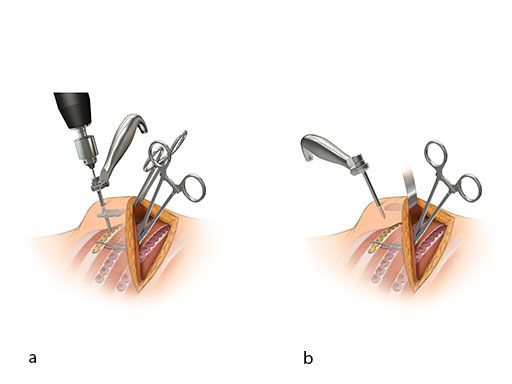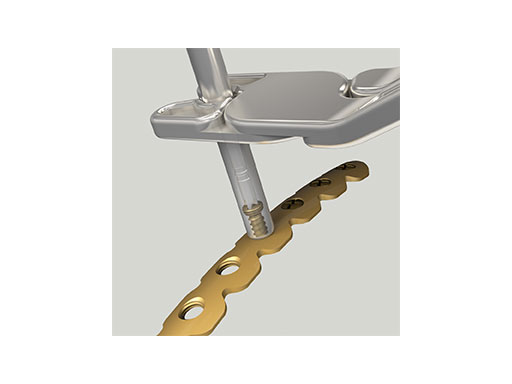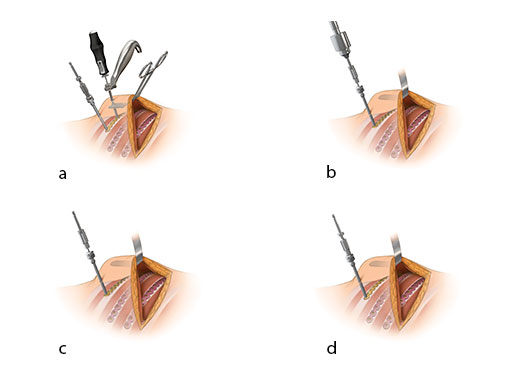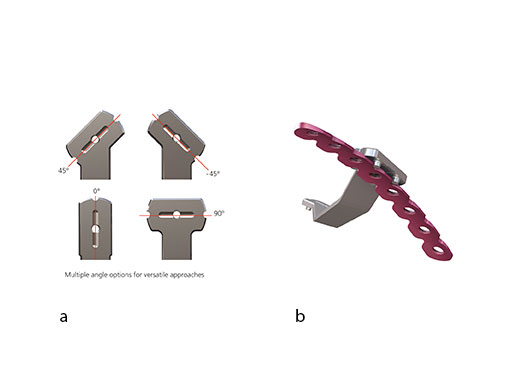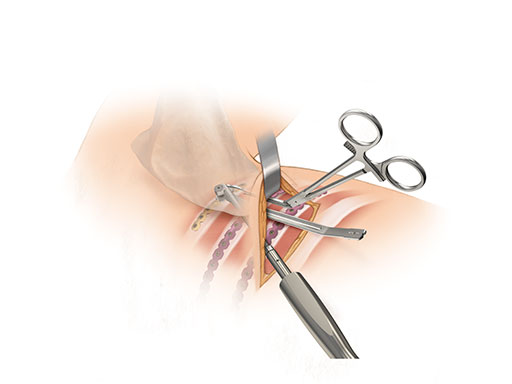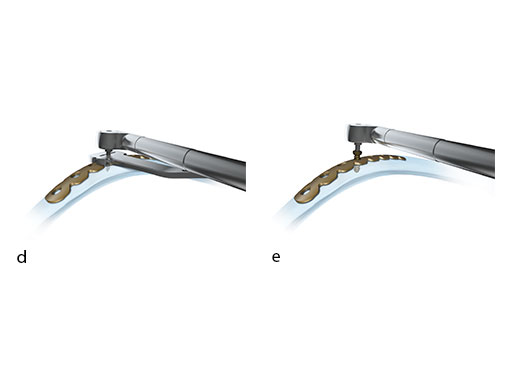
MatrixRIB - Minimally Invasive Plate Osteosynthesis
Paul Barbosa, Mark Lee
Although some rib fractures are treated with pain management and bracing, as well as endotracheal intubation and mechanical ventilation, if necessary, some patients could further benefit from surgical stabilization (osteosynthesis). The potential benefits of surgical stabilization of fractures include reduced duration of mechanical ventilation support, shortened ICU stays and hospitalization, better secretion management through efficient coughing, and minimized chest wall deformities resulting from trauma.
Furthermore, studies have demonstrated increased morbidity in patients with rib fractures after blunt trauma, not only in elderly patients, but in those as young as 45-years-old presenting more than four rib fractures. These severe injuries increase the risk of adverse outcomes, including inhospital mortality.
Now, the Thorax Surgery Working Group, also within the AOTK System, has continued the development of the system, which focuses on implants and instruments to provide a minimally invasive plate osteosynthesis solution for rib fixation.
The Matrix Rib Fixation System (indicated for the fixation and stabilization of rib fractures, fusions, and osteotomies of normal and osteoporotic bone), was developed in 2009 under the guidance of cardiothoracic and plastic surgeons within the CMF branch of the AOTK System (Fig 1).
Minimally Invasive Plate Osteosynthesis instrumentation has been developed to support less invasive approaches for rib fracture stabilization by extending their reach without the need to extend incision size in challenging access areas (eg, higher rib levels and subscapula fractures).
Specifically devised for this procedure, large Plate Holding Forceps (Fig 2a) aid to initially secure the plate to the fractured rib. An upright version of the forceps improves visibility while its ball tip design, centered in the plate screw hole, helps to hold the plate-rib construct in place.
A trocar with universal handle and its related instruments such as a cannula (Fig 2a and b) and a 2.2 mm threaded drill guide for MatrixRIB locking plates, are intended to be used in combination with the appropriate size drill bit with stop for a safe drilling when reaching the rib's second cortex. The drill guide can be threaded to the locking plate through the cannula to ensure a perpendicular entry and precision in terms of concentric drilling in the plate hole. This benefits later screw insertion, especially for the second and third screws, where there is no longer a margin for plate mobility to adjust centering. The angled tissue reduction forceps (Fig 2b) can be clamped to the trocar cannula (Fig 3), allowing soft tissue manipulation and improved visibility.
Alternatively to reduction forceps, the new Threaded Reduction Tool (TRT) (Fig 4a) is a useful instrument to nicely reduce and hold the rib as well as distract fractures through a small incision. It can be attached to a power tool with AO coupling (Fig 4b). Introducing it through the trocar drill guide, which is itself threaded to the plate, it allows to engage the rib thanks to its self-drilling end with a maximum insertion stop of 15 mm (instructions reflected in the technique guide must be followed to limit the insertion to patient's rib thickness and to avoid injuries). Once the power tool has been removed, rib fracture reduction is achieved by tightening the TRT reduction nut (Fig 4c and d). Later, a 2.9 mm locking screw can be inserted in the same screw hole after TRT removal. A limitation for using this tool is the bone quality of the patient.
Drill guides with multiple angle options and flat head (Fig 5a) were designed to allow engaging and holding the desired plate hole (Fig 5b), as well as to perform a controlled drilling. Dedicated drill bits to be used with the 90 screw driver handle (Fig 5c) have limited drilling depth to ensure a safe drilling (Fig 5d). This concept used with the 90 screw driver blades with self-retainer features (Fig 5e) aids reaching inaccessible fractured areas, including the end holes of the rib plates, thanks to the notches at both ends of the guiding groove.
Thorax Minimally Invasive Plating Technique
References
- Ahmed Z, Mohyuddin Z. Management of flail chest injury: internal fixation versus endotracheal intubation and ventilation. J Thorac Carfiovasc Surg. 1995 Dec; 110(6):16761680.
- Tanaka H, Yukioka T, Yamaguti Y, et al. Surgical stabilization of internal pneumatic stabilization? A prospective randomized study of management of severe flail chest patients. J Trauma. 2002 Apr; 52(4):727732.
- Holcomb JB, McMullin NR, Kozar RA, et al. Morbidity from rib fractures increases after age 45. J Am Coll Surg. 2003 Apr; 196(4):549555.
- Todd SR, McNally MM, Holcomb JB, et al. A multidisciplinary clinical pathway decreases rib fracture-associated infectious morbidity and mortality in high-risk trauma patients. Am J Surg. 2006 Dec; 192(6):806811.
- Kent R, Woods W, Bostrom O. Fatality risk and the presence of rib fractures. Ann Adv Automot Med. 2008 Oct; 52:7382.
Hazards and labeling
Due to varying countries’ legal and regulatory approval requirements, consult the appropriate local product labeling for approved intended use of the products described on this website. All devices on this website are approved by the AO Technical Commission. For logistical reasons, these devices may not be available in all countries worldwide at the date of publication.
Legal restrictions
This work was produced by AO Foundation, Switzerland. All rights reserved by AO Foundation. This publication, including all parts thereof, is legally protected by copyright.
Any use, exploitation or commercialization outside the narrow limits set forth by copyright legislation and the restrictions on use laid out below, without the publisher‘s consent, is illegal and liable to prosecution. This applies in particular to photostat reproduction, copying, scanning or duplication of any kind, translation, preparation of microfilms, electronic data processing, and storage such as making this publication available on Intranet or Internet.
Some of the products, names, instruments, treatments, logos, designs, etc referred to in this publication are also protected by patents, trademarks or by other intellectual property protection laws (eg, “AO” and the AO logo are subject to trademark applications/registrations) even though specific reference to this fact is not always made in the text. Therefore, the appearance of a name, instrument, etc without designation as proprietary is not to be construed as a representation by the publisher that it is in the public domain.
Restrictions on use: The rightful owner of an authorized copy of this work may use it for educational and research purposes only. Single images or illustrations may be copied for research or educational purposes only. The images or illustrations may not be altered in any way and need to carry the following statement of origin “Copyright by AO Foundation, Switzerland”.
Check www.aofoundation.org/disclaimer for more information.
If you have any comments or questions on the articles or the new devices, please do not hesitate to contact us.
“approved by AO Technical Commission” and “approved by AO”
The brands and labels “approved by AO Technical Commission” and “approved by AO”, particularly "AO" and the AO logo, are AO Foundation's intellectual property and subject to trademark applications and registrations, respectively. The use of these brands and labels is regulated by licensing agreements between AO Foundation and the producers of innovation products obliged to use such labels to declare the products as AO Technical Commission or AO Foundation approved solutions. Any unauthorized or inadequate use of these trademarks may be subject to legal action.
AO ITC Innovations Magazine
Find all issues of the AO ITC Innovations Magazine for download here.
Innovation Awards
Recognizing outstanding achievements in development and fostering excellence in surgical innovation.



